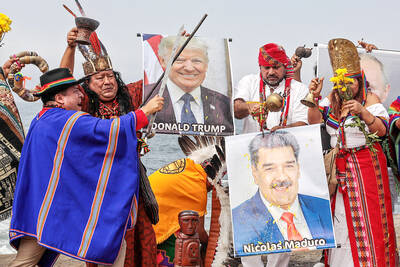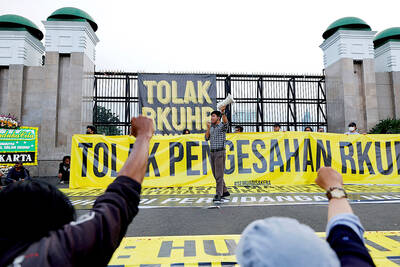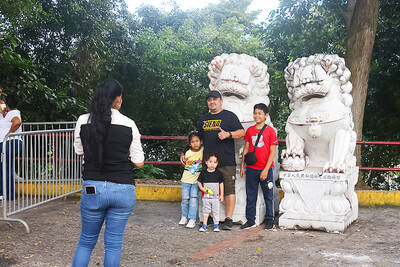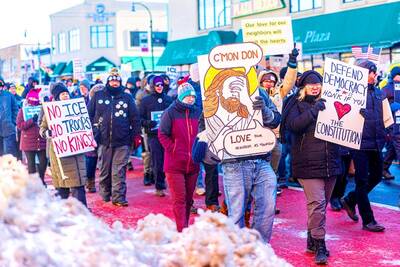Singapore kicked off a global rush to develop contact tracing apps for the novel coronavirus when the city-state launched an apparently new system in March, but the project actually drew inspiration from a 2014 US high school project that won an international prize, but found no backers — until now.
It all started when Rohan Suri created an app at Thomas Jefferson High School in Alexandria, Virginia, to tell his mom to leave home for the bus stop when he was seven minutes away.
As the Ebola epidemic ravaged western Africa at the time, Suri and schoolmate Claire Scoggins connected the dots between tracking apps and contact tracers who ask patients whom they may have spread viruses to.
“I got really interested in basically automating a lot of these contact tracing efforts,” Suri said, citing a staff shortage in parts of Africa during the Ebola epidemic.
When Suri and Scoggins developed a prototype called kTrace, they appealed to medical aid organizations and the US government to bring it to the front lines.
However, they found no takers, even after winning third place for systems software at the 2015 International Science and Engineering Fair.
The app languished until Suri, now a 21-year-old junior at Stanford University, got an e-mail on Jan. 24 from Jason Bay, a Stanford alum and senior director at Singapore’s Government Technology Agency (GovTech).
“My mom had texted me saying: ‘You’ve got to look at this virus in Wuhan and do something about it,’” Suri said. “I didn’t take it seriously, though, and week later the Singapore government is reaching out.”
Bay’s team had been looking for technology to help curb the spread of COVID-19 and came across kTrace online.
Suri spent February and March volunteering on GovTech’s TraceTogether app, alongside fellow Stanford students Nikhil Cheerla and Daniel Lee.
They said they gave Singapore a roadmap by sharing kTrace’s code and providing advice in virtual meetings on stronger privacy protections.
Singapore was “just looking around for any way to speed up the development process and we fit in,” Cheerla said.
The agency said that it contacted Suri “to understand his experiences and considerations in designing kTrace for Android.”
However, Suri “did not commit code to TraceTogether, nor did [GovTech] use kTrace in the development of TraceTogether,” it said.
University scientists Kate Farrahi and Manuel Cebrian said their studies as early as 2011 were the first to show Bluetooth readings could aid contact tracing, but they did not develop an app, and Suri had not seen their work in high school.
Since Singapore’s app launched, several dozen governments, including Australia, Britain and US states such as North Dakota, have spent millions of dollars among them to develop separate tracing apps.
Many other governments are monitoring progress in Singapore, where about 25 percent of its 5.6 million residents have downloaded TraceTogether.
Contact tracing apps aim to slow the spread of viruses by identifying secondhand infections more quickly than through interviews, but privacy concerns are a hurdle, and the technology does not work well on iPhones.
Singapore has adopted a costly solution: Giving residents small tracing gadgets that do not require smartphones.
Suri said he, too, had developed a wearable device in high school, because Ebola infections were highest in countries with low smartphone ownership.
Suri is now focusing on a third app called Zero, aimed at US cities.
The day after TraceTogether launched, a friend who knew about Suri’s involvement introduced him to some New York entrepreneurs and venture capitalists seeking to bring similar technology to the US.
They ended up cofounding Zero, which aims to attract users by bundling contact tracing technology with a safety-rating tool for shops and restaurants.

Shamans in Peru on Monday gathered for an annual New Year’s ritual where they made predictions for the year to come, including illness for US President Donald Trump and the downfall of Venezuelan President Nicolas Maduro. “The United States should prepare itself because Donald Trump will fall seriously ill,” Juan de Dios Garcia proclaimed as he gathered with other shamans on a beach in southern Lima, dressed in traditional Andean ponchos and headdresses, and sprinkling flowers on the sand. The shamans carried large posters of world leaders, over which they crossed swords and burned incense, some of which they stomped on. In this

Indonesia yesterday began enforcing its newly ratified penal code, replacing a Dutch-era criminal law that had governed the country for more than 80 years and marking a major shift in its legal landscape. Since proclaiming independence in 1945, the Southeast Asian country had continued to operate under a colonial framework widely criticized as outdated and misaligned with Indonesia’s social values. Efforts to revise the code stalled for decades as lawmakers debated how to balance human rights, religious norms and local traditions in the world’s most populous Muslim-majority nation. The 345-page Indonesian Penal Code, known as the KUHP, was passed in 2022. It

Near the entrance to the Panama Canal, a monument to China’s contributions to the interoceanic waterway was torn down on Saturday night by order of local authorities. The move comes as US President Donald Trump has made threats in the past few months to retake control of the canal, claiming Beijing has too much influence in its operations. In a surprising move that has been criticized by leaders in Panama and China, the mayor’s office of the locality of Arraijan ordered the demolition of the monument built in 2004 to symbolize friendship between the countries. The mayor’s office said in

‘TRUMP’S LONG GAME’: Minnesota Governor Tim Walz said that while fraud was a serious issue, the US president was politicizing it to defund programs for Minnesotans US President Donald Trump’s administration on Tuesday said it was auditing immigration cases involving US citizens of Somalian origin to detect fraud that could lead to denaturalization, or revocation of citizenship, while also announcing a freeze of childcare funds to Minnesota and demanding an audit of some daycare centers. “Under US law, if an individual procures citizenship on a fraudulent basis, that is grounds for denaturalization,” US Department of Homeland Security Assistant Secretary Tricia McLaughlin said in a statement. Denaturalization cases are rare and can take years. About 11 cases were pursued per year between 1990 and 2017, the Immigrant Legal Resource